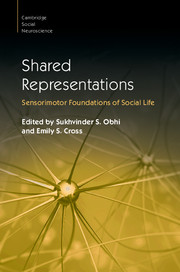Book contents
- Shared Representations
- Cambridge Social Neuroscience
- Shared Representations
- Copyright page
- Contents
- Figures
- Tables
- Boxes
- Contributors
- Preface
- Part I Foundations
- Part II Imitation and Mimicry
- Part III Thinking, Perceiving and Acting with Others
- Part IV Understanding Others
- 15 The Social Function of the Human Mirror System
- 16 Biological Tuning of Mirror Mechanisms
- 17 Representation of Self versus Others’ Actions
- 18 Reading Intention in Action
- 19 Complementary Actions
- 20 Emotional Convergence
- Part V Learning and Development
- Part VI Shared Representations in Applied Contexts
- Index
- Plate Section (PDF Only)
- References
19 - Complementary Actions
from Part IV - Understanding Others
Published online by Cambridge University Press: 27 October 2016
- Shared Representations
- Cambridge Social Neuroscience
- Shared Representations
- Copyright page
- Contents
- Figures
- Tables
- Boxes
- Contributors
- Preface
- Part I Foundations
- Part II Imitation and Mimicry
- Part III Thinking, Perceiving and Acting with Others
- Part IV Understanding Others
- 15 The Social Function of the Human Mirror System
- 16 Biological Tuning of Mirror Mechanisms
- 17 Representation of Self versus Others’ Actions
- 18 Reading Intention in Action
- 19 Complementary Actions
- 20 Emotional Convergence
- Part V Learning and Development
- Part VI Shared Representations in Applied Contexts
- Index
- Plate Section (PDF Only)
- References
Summary
Human beings come into the world wired for social interaction. At the fourteenth week of gestation, twin fetuses already display interactive movements specifically directed towards their co-twin. Readiness for social interaction is also clearly expressed by the newborn who imitates facial gestures, suggesting that there is a common representation mediating action observation and execution. While actions that are observed and those that are planned seem to be functionally equivalent, it is unclear if the visual representation of an observed action inevitably leads to its motor representation. This is particularly true with regard to complementary actions (from the Latin complementum; i.e. that fills up), a specific class of movements which differ, while interacting, with observed ones. In geometry, angles are defined as complementary if they form a right angle. In art and design, complementary colors are color pairs that, when combined in the right proportions, produce white or black. As a working definition, complementary actions refer here to any form of social interaction wherein two (or more) individuals complete each other’s actions in a balanced way. Successful complementary interactions are founded on the abilities: (1) to simulate another person’s movements; (2) to predict another person’s future action/s; (3) to produce an appropriate congruent/incongruent response that completes the other person’s action/s; and (4) to integrate the predicted effects of one’s own and another person’s actions. It is the neurophysiological mechanism that underlies this process which forms the main theme of this chapter.
- Type
- Chapter
- Information
- Shared RepresentationsSensorimotor Foundations of Social Life, pp. 392 - 416Publisher: Cambridge University PressPrint publication year: 2016
References
- 3
- Cited by

